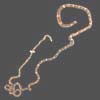
 |
Nemertea from SF Bay
The nemerteans are soft-bodied,
unsegmented worms, often with few easily observed, external diagnostic features.
This forces taxonomists to rely heavily upon nemertean internal anatomy and
histology to make accurate identifications.
Different species vary greatly in size. Some species are as small as 1 millimeter
long, but there are true giants that can extend themselves to 30 meters (about
100 ft) in length. Because these worms are extremely flexible and can lengthen
their bodies up to five times their minimum lengths, our size estimates can
only be just that…estimates!
The most distinctive features of a nemertean are its general shape, which is
vermiform (worm-shaped) and unsegmented, as well as its long proboscis
(an eversible organ that lies in an anterior, internal cavity called the rhynchocoel).
This organ is everted (or shot out) from the mouth or proboscis
opening (some nemerteans have these orifices separated) when the animal is hunting,
defending itself, or moving along the substrate. Most species of nemerteans
are carnivorous, eating small invertebrates (such as annelids and crustaceans)
and their eggs. Others live symbiotically in the shells of mollusks, feeding
on plankton and microbes that are filtered by their host. There are also omnivorous
species. Most commonly, the gonadal systems are simple, and reproduction involves
spawning by separate sexes. A few species exhibit internal fertilization. Fragmentation
is also possible, allowing broken sections of worm to regenerate a head, tail,
or both.
There are about 1,000 known species
of nemerteans (and probably several times this number yet to be discovered).
Most nemertean worms are marine, although there are a few freshwater and terrestrial
species. They are not an especially well known group, as they live relatively
concealed lives, and there are few systematists working on them. Many of the
less brightly colored species hide by day and emerge to feed only at night.
Some species are also capable of forming protective tubes or cysts of mucus
during periods of breeding or environmental stress.
Most nemerteans found in San Francisco Bay are very small and not easily identifiable.
An exception to this is Tubulanus sexlineatus
(see photo and description).
mmm |
Baseodiscus sp. |
mmm |
Carinoma mutabilis Griffin, 1898 |
mmm |
Cerebratulus californiensis Coe, 1905 |
mmm |
Micrura verrilli Coe, 1905 |
mmm |
Paranemertes sp. |
| Tubulanus sexlineatus (Griffin, 1898) |